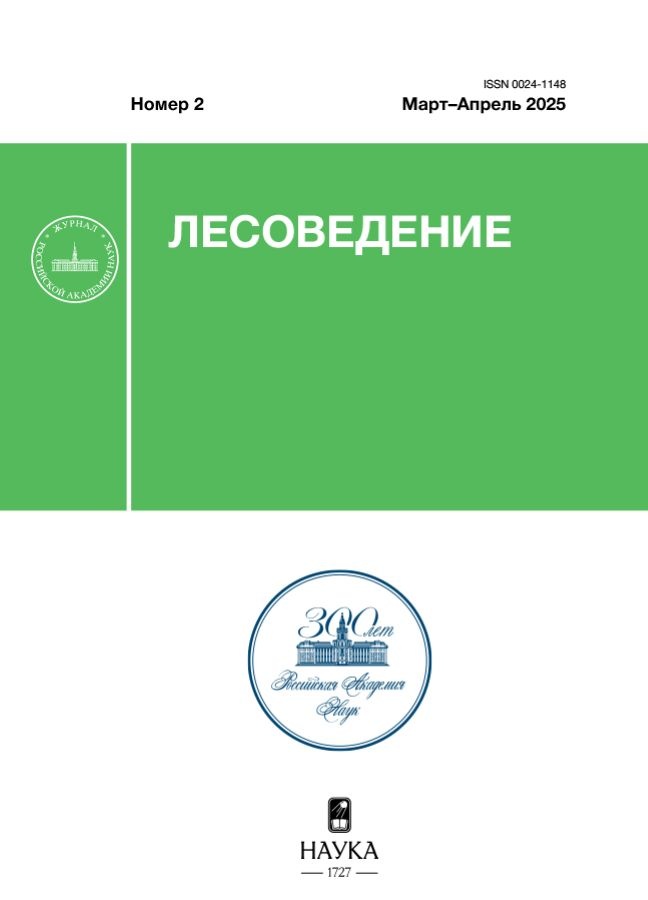Marshy spruce forests of the Zapadnodvinsky district of the Tver region: structure of forest stands and peat deposits
- Authors: Storozhenko V.G.1, Glukhova T.V.1
-
Affiliations:
- Institute of Forest Science of the Russian Academy of Sciences
- Issue: No 2 (2025)
- Pages: 171-181
- Section: RESEARCH
- URL: https://consilium.orscience.ru/0024-1148/article/view/686870
- DOI: https://doi.org/10.31857/S0024114825020024
- EDN: https://elibrary.ru/FXLYLV
- ID: 686870
Cite item
Abstract
Swamp spruce forests growing on eutrophic peatlands with mixed water-mineral nutrition can vary in the composition of tree layer species and the structure of the peat deposit during succession changes. Sample plots were created in two swamp spruce forests: swamp-grass (PP1) and swamp-broadleaved-herbs-green-moss (PP2) in the Velessky forestry of the Zapadnodvinsky district of the Tver region. The research is aimed at studying the age, renewal, fallen trees and dynamic characteristics, structure of peat deposits and successional dynamics of swamp spruce forests. The studied swamp spruce forests are unevenly-aged mixed communities of complex vertical structure, consisting of Norway spruce (Pícea ábies L.), black alder (Álnus glutinósa L.), downy birch (Вetula pubescens L.), rarely aspen (Populus tremula L.), but with a significant predominance of spruce. Uniformity of tree volumes distribution in age generations in ascending or descending order determines the tendency of the correlation between age and tree volumes, tending to maximum values, up to the functional one (R2 = 0.936). The more uniform the values of tree volumes in generations of age series of forest stands, the closer the correlation of the indicators. The species composition’s change dynamics of forest stands is associated with the moisture values in the community area. The soils of the swamp spruce forests are lowland peat (Fibric Histosols Eutric), composed of thick (up to 5 m) sedge-woody peats in the swamp-grass spruce forest and woody peats (up to 2 m) with a high degree of decomposition (25—45%) in the swamp-broadleaved-herbs-green-moss spruce forest. In swamp spruce forests with mixed composition of tree species intensive processes of the forest stands’ composition’s purification take place, resulting in displacement of deciduous species and formation of pure spruce biogeocenoses, close to climax phases of dynamics. With similarity of the swamp spruce forests’ peat soils’ structure, small differences in the degree of decomposition, ash content, density can still be noted, which are explained by the features of the relief and hydrological regime of the territories.
Full Text
About the authors
V. G. Storozhenko
Institute of Forest Science of the Russian Academy of Sciences
Author for correspondence.
Email: lesoved@mail.ru
Russian Federation, Sovetskaya str., 21, Uspenskoe village, Moscow region, Odintsovo urban district, 143030
T. V. Glukhova
Institute of Forest Science of the Russian Academy of Sciences
Email: lesoved@mail.ru
Russian Federation, Sovetskaya str., 21, Uspenskoe village, Moscow region, Odintsovo urban district, 143030
References
- Arinushkina E.V., Rukovodstvo po khimicheskomu analizu pochv (Handbook on chemical analysis of soils), Moscow: Izd-vo MGU, 1970, 487 p.
- Dvoretskii M.L., Posobie po variatsionnoi statistike (Manual on analysis of variance), Moscow: Lesnaya promyshlennost’, 1971, 103 p.
- Dyrenkov S.A., Struktura i dinamika taezhnykh el’nikov (Structure and dynamics of the boreal spruce forest), Leningrad: Nauka, 1984, 174 p.
- Golovchenko A.V., Gracheva T.A., Semenova T.A., Morozov A.A., Samigullina S.R., Glukhova T.V., Inisheva L.I., Mitselial’nyi komponent eutrofnykh torfyanykh pochv v zone aktivnoi destruktsii organicheskogo detrita (The mycelial component of eutrophic peat soils in the zone of active organic detritus decomposition), Pochvovedenie, 2023, No. 5, pp. 536—549.
- Kutenkov S.A., Borovichev E.A., Koroleva N.E., Kopeina E.I., Kostina V.A., Drugova T.P., Petrova O.V., Flora i rastitel’nost’ okhranyaemogo evtrofnogo bolota v Yuzhnom Prikhibin’e (Murmanskaya oblast’) (Flora and vegetation of a protected eutrophic fen at the southern foothills of the Khibiny mountains (Murmansk region)), Trudy KarNTs RAN. Ser. Biogeografiya, 2019, No. 8, pp. 80—96.
- P’yavchenko N.I., Nekotorye itogi statsionarnogo izucheniya vzaimootnoshenii lesa i bolota v Zapadnoi Sibiri (Some results of stationary study of forest-swamp relationships in Western Siberia), In: Vzaimootnosheniya lesa i bolota (Forest-swamp relationships), Moscow: Nauka, 1967, pp. 742.
- P’yavchenko N.I., O vzaimootnosheniyakh lesa i bolota (About the relationship between forest and swamp), Lesovedenie, 1980, No. 3, pp. 24—33.
- P’yavchenko N.I., Tipy bolotnykh lesov Tomskogo statsionara (Types of swamp forests of the Tomsk station), In: Osobennosti bolotoobrazovaniya v nekotorykh lesnykh i predgornykh raionakh Sibiri i Dal’nego Vostoka (Features of swamp formation in some forest and foothill areas of Siberia and the Far East), Moscow: Nauka, 1965, pp. 97—113.
- Semenskii E.P., Tekhnicheskii analiz torfa (Technical analysis of peat), Moscow: Nedra, 1966, 231 p.
- Sortimentnye i tovarnye tablitsy dlya lesov tsentral’nykh i yuzhnykh raionov Evropeiskoi chasti RSFSR, (Stand assortment tables for forests of the central and southern regions of the European part of the RSFSR), Approved by the Order of the State Forestry Agency of the USSR dated 23.12.1986, No. 258, 191 p.
- Storozhenko V.G., Datirovka razlozheniya valezha eli (Dating of spruce brushwood decay), Ekologiya, 1990, No. 6, pp. 66—69.
- Storozhenko V.G., Drevesnyi otpad v korennykh lesakh Russkoi ravniny (Woody debris in primary forests of the East European plain), Moscow: Tovarishchestvo nauchnykh izdanii KMK, 2011, 122 p.
- Storozhenko V.G., Glukhova T.V., Struktura i sostoyanie drevostoya na nizinnom chernool’khovom bolote Tverskoi oblasti (Structure and condition of the lowland black alder swamp stand in the Tver region), Lesovedenie, 2022, No. 5, pp. 494—503.
- Storozhenko V.G., Ustoichivye lesnye soobshchestva: teoriya i eksperiment (Sustainable forest communities: theory and experiment), Moscow: Grif i K, 2007, 190 p.
- Tret’yakov N.V., Gorskii P.V., Samoilovich G.G., Spravochnik taksatora (Handbook for taxators), Moscow-Leningrad: Goslesbumizdat, 1952, 854 p.
- Vasilevich V.I., Dominantno-floristicheskii podkhod k vydeleniyu rastitel’nykh assotsiatsii (Dominant-floristic approach to the distinction of plant association), Botanicheskii zhurnal, 1995, Vol. 80, No. 6, pp. 28—40.
- Vomperskii S.E., Glukhov A.I., Geomorfologicheskoe polozhenie bolotnykh lesov i bezlesnykh bolot razlichnogo genezisa (Geomorphological position of bog forests and treeless bogs of various genesis), In: Biogeotsenologicheskoe izuchenie bolotnykh lesov v svyazi s opytnoi gidromelioratsiei (Biogeocenological study of bog forests in connection with experimental hydromelioration), Moscow: Nauka, 1982, pp. 50—56.
Supplementary files











